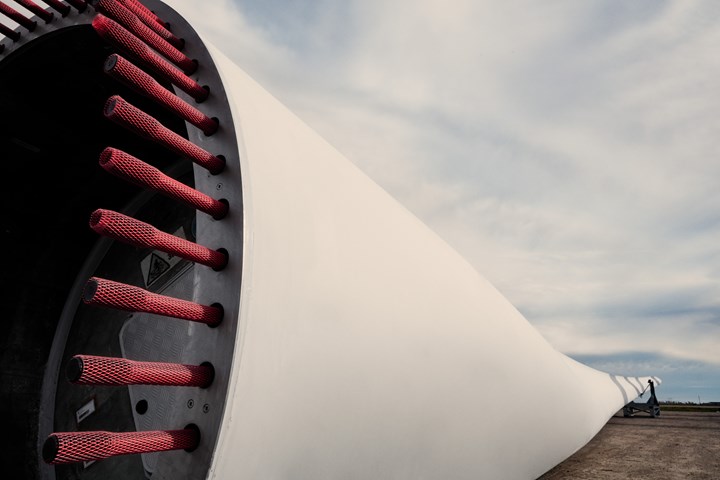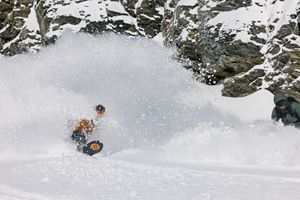CETEC initiative established to commercialize technology for full composite wind turbine blade recyclability
New coalition involving Vestas, Olin, Danish Technological Institute and Aarhus University aims to close the recycling gap for thermoset epoxy composites.

Photo Credit: LM Windpower/Piet Simosen.
A coalition of industry and academic leaders have developed a new technology which will deliver the final technological step toward enabling circularity for thermoset composites used to make wind turbine blades. To ensure its adoption, and to advance a circular economy across the wind industry, a new initiative entitled CETEC (Circular Economy for Thermoset Epoxy Composites) has been established. Within three years, CETEC is aiming to present a full-scoped solution ready for industrial adoption, based on commercialization of the novel technology.
Partly funded by Innovation Fund Denmark (IFD, Aarhus, Denmark), CETEC is spearheaded by Vestas (Aarhus), a sustainable energy solutions leader, and involves both industrial and academic leaders including Olin Corp. (Clayton, Miss., U.S.), producer of epoxy, the Danish Technological Institute (DTI, Taastrup, Denmark), and Aarhus University (Denmark).
Developed by DreamWind, an innovation initiative driven by the same partners, the new technology consists of a two-step process. First, thermoset composites are disassembled into reinforcement fiber and resin (epoxy). Then, through a novel chemcycling process, the epoxy is further broken up into base components similar to virgin materials. These materials can then be reintroduced into the manufacturing of new turbine blades, constituting a new circularity pathway for epoxy resin.
“Chemcycling of epoxy-based materials would allow deconstructing these highly stable polymer chains into molecular building blocks. These building blocks are easily processable and can be used to produce new epoxy, which will have the same quality as the original material,” notes Prof. Dr. Troels Skrydstrup, Aarhus University. “Avoiding the loss of valuable molecular complexity in such a way is a highly desirable concept and an important step to sustainable materials.”
According to partners, wind turbines are 85-90% recyclable, with turbine blade material constituting the remaining percentage that cannot be recycled, due to the nature of thermoset composites (see “Defining the landscape for wind blades at the end of service life” for more on EOL wind blades). CETEC is aiming to close this recycling gap and enable a significant step forward in the elimination of waste across the wind energy industry.
“As global commitments to a net-zero future increase, it’s crucial to ensure the wind industry can scale sustainably, which includes Vestas fulfilling our ambition to produce zero-waste turbines by 2040,” says Allan Korsgaard Poulsen, head of Sustainability and Advanced Materials, Vestas Innovation and Concepts. “Leveraging this new technological breakthrough in chemcycling epoxy resin, the CETEC project will be a significant milestone in Vestas’ journey towards achieving this goal, and in enabling a future where landfill is no longer required in blade decommissioning.”
“The key characteristic of composite materials is their unique combination of low weight and high strength. This is governed by the strong bonding of two different materials — fiber and epoxy,” Simon Frølich, team manager, PhD, Danish Technological Institute adds. “The dilemma is that this strong bond is also the feature that renders these materials difficult to recycle. Therefore, the development of CETEC’s novel technology, enabling disassembly of the composite at EOL is a game-changer, that will allow us to capture the value represented by each material stream in a new circular value chain.”
In conclusion, CETEC’s solution plans to address the lack of available recycling technology for epoxy resins. This would in turn create the possibility to introduce new recycling solutions to the wind industry. This reportedly holds significant potential for commercial value capture, particularly in markets where regulation around waste management for manufacturing industries is tightening to serve a broader sustainability agenda. When fully developed, the solution may also have an impact for other industries that rely on thermoset composite in production, such as automotive and aviation.
“As a leading epoxy producer and global supplier for the wind industry, Olin is proud to provide our technological expertise to this important sustainability project,” says Leif Ole Meyer, TS&D leader EMEAI at Olin. “To develop technologies which close an existing gap of thermosets by creating a circularity is yet another example of putting our resource efficiency sustainability goal into action. This innovation will help the industry to minimize consumption of virgin material sources and increase the reuse and recycling of materials.”
Related Content
TCR Composites introduces TR1116 snap-cure epoxy prepreg resin system
Designed for press-cure applications, the resin system is highlighted for its snap-cure capability and tailored properties.
Read MorePlant tour: Albany Engineered Composites, Rochester, N.H., U.S.
Efficient, high-quality, well-controlled composites manufacturing at volume is the mantra for this 3D weaving specialist.
Read MoreBio-based epoxy, recycled materials increase sustainability of all-terrain snowboards
Aiming for a smaller environmental footprint while maintaining high performance, Salomon’s Highpath snowboard line incorporates bio-based epoxy, glass and basalt fiber stringers and recycled materials.
Read MoreComposite molding compound replaces Invar for lightweight small satellite structures
Patz Materials and Technologies and Lawrence Livermore National Laboratory developed a new monolithic optics housing with 80% less weight, near-zero CTE and the high-volume manufacturing required for commercial space.
Read MoreRead Next
U.K. launches initiative for recyclable wind turbine blade technologies
The SusWIND initiative, addressing the recyclability and future development of composite wind turbine blades, will be delivered in three developments.
Read MorePlant tour: Daher Shap’in TechCenter and composites production plant, Saint-Aignan-de-Grandlieu, France
Co-located R&D and production advance OOA thermosets, thermoplastics, welding, recycling and digital technologies for faster processing and certification of lighter, more sustainable composites.
Read MoreVIDEO: High-volume processing for fiberglass components
Cannon Ergos, a company specializing in high-ton presses and equipment for composites fabrication and plastics processing, displayed automotive and industrial components at CAMX 2024.
Read More





















